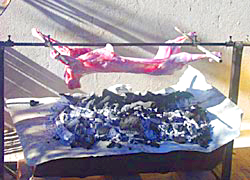|
Cabrito
Young Goat (Kid) |
|||||
|
Today Adriana, with help from husband Juan and son Nery, will prepare cabrito three ways. Cabrito al Carbon, Cabrito en su Sangre, and Cabrito Michote. One of the two cabrito carcasses will be left whole for the al carbon, and the other will be cut in half in the midsection for the other two dishes. |
|||||
 |
Cabrito al Carbon This was the first order of cooking because it needs about three and a half hours cooking time. Nery begins by attaching metal rods to the legs. Then he and his father attach the rods to the rotisserie shaft that rests on a stand.
Which they move over the bed of hot charcoal. The rotisserie crank is turned over about every 30 minutes. |
 |
|||
 |
 |
||||
|
|
|||||
 |
Juan is adding mesquite chips to the fire while Adriana is brushing on a spicy sauce. It is the same sauce she made for the cabrito Michote which we'll see below. The sauce is brushed on both sides several times during the last hour. Very tasty. |
 |
|||
|
|
|||||
 |
Cabrito en su Sangre The carrots, celery, peas and beans shown here are just representative of the 2½ cups of finely diced veggies that will go into the dish. Other spices shown are garlic, onion, thyme, marjoram, laurel, and (ugh) congealed blood saved from the slaughter. The rear half of the second carcass is cut into serving size pieces which are browned in olive oil before being moved to a larger skillet for the final cooking. A few laurel leaves are placed on top of the browned meat, then the pan is covered and set over low heat. With the meat simmering away, Adriana begins the next phase by dicing all the internal organs (offal) which were saved at the slaughter -- heart, lungs, liver, stomach, kidneys, well cleaned intestines, etc -- everything. While the offal sautés in olive oil, she blends the spices with a bit of water, and then adds this to the meat which has cooked for about half an hour.
After the offal is added to the meat and simmered for a few minutes, she prepares the blood by liquefying and smoothing it in the blender before briefly sautéing. After the blood is stirred in and simmered for a bit, the finely diced, raw veggies are added to cook for another half hour, or until the carrots are soft. Chopped cilantro is sprinkled on just before serving. |
 |
|||
 |
 |
||||
 |
 |
||||
 |
 |
||||
 |
|
 |
|||
|
The total cooking time is about an hour, or until the veggies are done and the meat is falling off the bones. Don't let the name of this dish or some of its ingredients turn you off. I'll admit that I was pretty unsure as I watched her making it, but the final dish was OMG good! This was the best cabrito I have ever eaten. And I'm a big fan of cabrito. If you buy a cabrito in the grocery store, you'll not find the offal or the blood which really do add so much to the flavor of the dish. Chicken gizzards, hearts and livers might be an OK partial substitute. |
|||||
|
|
|||||
 |
Cabrito Michote Nery cuts the front half of the carcass into serving size pieces. The chile colorado salsa will have three kinds of chiles -- ancho, pasilla, and puya. Puyas (also called pipitillas) are very hot, so be careful. |
 |
|||
  |
|
 
|
|||
|
The chiles have been sautéed until they are soft. Onion, garlic, oregano, Tone's seafood seasoning, and water are blended to make the sauce for this dish and for the cabrito al carbon as we saw above. |
Adriana massages each piece to be sure it is completely coated with the sauce. |
||||
 |
|
 |
|||
|
Each piece is wrapped in aluminum foil and placed in a steamer to cook for about an hour. This is just like we saw in pollo adobo.
|
The final product is a slightly spicy and very tasty treat. |
||||
| If you wish to write to Adriana Rosales you may send an e-mail to AdrianaR@rollybrook.com | |||||



